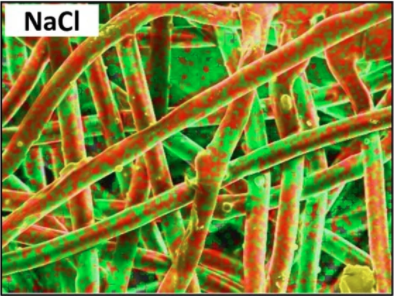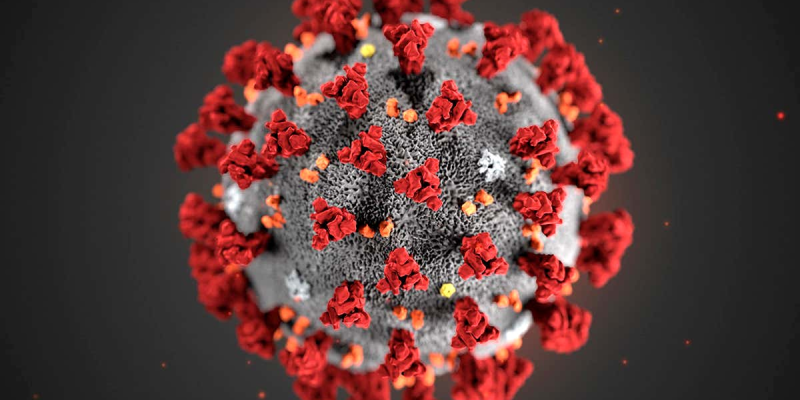Masks are proven tools against airborne diseases, but pathogens — like the COVID-19 virus — can collect in a mask and survive which complicates handling and disposal. [Ilaria Rubino], a researcher at the University of Alberta, recently received an award for her work showing how treating a mask’s main filtration layer with a solution of mostly salt and water (plus a surfactant to help the wetting process) can help a mask inactivate pathogens on contact, thereby making masks potentially re-usable. Such masks are usually intended as single-use, and in clinical settings used masks are handled and disposed of as biohazard waste, because they can contain active pathogens. This salt treatment gives a mask a kind of self-cleaning ability.

How exactly does salt help? The very fine salt coating deposited on the fibers of a mask’s filtration layer first dissolves on contact with airborne pathogens, then undergoes evaporation-induced recrystallization. Pathogens caught in the filter are therefore exposed to an increasingly-high concentration saline solution and are then physically damaged. There is a bit of a trick to getting the salt deposited evenly on the polypropylene filter fibers, since the synthetic fibers are naturally hydrophobic, but a wetting process takes care of that.
The salt coating on the fibers is very fine, doesn’t affect breathability of the mask, and has been shown to be effective even in harsh environments. The research paper states that “salt coatings retained the pathogen inactivation capability at harsh environmental conditions (37 °C and a relative humidity of 70%, 80% and 90%).”
Again, the salt treatment doesn’t affect the mask’s ability to filter pathogens, but it does inactivate trapped pathogens, giving masks a kind of self-cleaning ability. Interested in the nuts and bolts of how researchers created the salt-treated filters? The Methods section of the paper linked at the head of this post (as well as the Methods section in this earlier paper on the same topic) has all the ingredients, part numbers, and measurements. While you’re at it, maybe brush up on commercially-available masks and what’s inside them.
















Masks aren’t reusable? I’ve been using the same mask every day since April. Probably washed about once a month or so.
If your mask is full of your own microbiota it would be a hostile environment for viral particles anyway. To bacteria that are not vulnerable to a virus they are just little packets of yummy protein to ingest and utilise. Now if you have your biota enhanced to specifically destroy a particular virus that would be an even better hack… Entirely doable too. Try Lactobacillus plantarum HEAL9 and Lactobacillus paracasei 8700:2 Adding salt just undermines that protection, unless you add halophiles.
Store bought masks are generally not reusable and should be washed after each use if you want to get any benefit out of it for yourself. Otherwise it’s only good at somewhat blocking your spit from leaving your mouth while speaking. If you wash it, the fibers get less fluffy, making the gaps larger, decreasing effectiveness over time.
Depends on the kind of mask. Surgical masks/procedure masks/N95s are not generally reusable. There are ways of cleaning them (hydrogen peroxide vapor) that don’t mess up the electrostatic charge.
Cloth masks are different. Can re-use them.
So we should better wash our masks in hot salt water? What salt concentration? Rock or sea salt? How long? Normal airdray of forced hot air/iron ?
Does this salt concentration near mouth effect the skin/lips ?
You also need to add detergent to the salt solution to wet the mask fibres thoroughly. Looking at “tween 20” that they used, normal washing up liquid will work here, and that quite often contains salt too (to make it thicker). Any old salt will do, including stuff they use to salt roads (but don’t include the grit!)
This is cool and all, but we made a video explaining this in March, and nobody cared at the time.
https://robots-everywhere.com/re_wiki/pub/web/Cookbook.SaltMask.html if anyone wants to see the writeup we did then.
https://youtu.be/K9nHgjtqHVA if anyone cares about the video (note the upload date).
You could even say that I am salty about it.
Justifiably so!
Please read before complaining: their first published paper about salt deactivation of virions his dated 2017:
https://www.nature.com/articles/srep39956
Considering the time was less of a rush for publications on the subject, they probably submitted a few month before that.
In addition, the article cited by the OP only talks about large pore masks for bacteria and does not seem to cite efficacy on virus (I won’t take the time to read the whole paper in detail).
Funny, I was doing this back in March when I was making my own n95-like masks using Zn and Cu solutions for 2 layers of Merv 13 filter and one outer layer of filter material(first MERV 13, later an outer layer of spun bound fabric from Sailrite) which I treated with super salt solution. Any weting problem was solved with a tiny amount of dish detergent.
Same problem here. We did manage to help a hospital in my hometown in Italy stay open during the initial emergency (although that was mostly a case of getting it across to the Carabinieri that letting us use a shop’s 3d printers to make face shields should not be counted as a curfew violation!), so there’s that, and it’s nice to see a paper in Nature published, just… it’d be nice if credit was given to the makers who improvised at the time.
Yep, I’ve got footage of us doing it on Feb 4, 2020 and a couple blog posts.
yes, you all had it really rough in Italy as one of the first countries hard hit after China and locking down was too late. My hat’s off to you and all the other makers in Italy who designed and improvised solution to keep people safe with PPE and with parts for ventilators, etc when parts were unavailable or with weeks of delivery times.
Maybe some day someone like Chris Paine will do a documentary on what the makers around the world did in 2020.
Gui Cavalcanti did a fantastic job organizing people in California, so that’s a good starting point!
So how does the filtration compare to the filtration of the main filtration layers of a surgical mask?
How does filtration hold up under use (storing may not be same as breathing through it for 8 hours in 90 degrees, 80+ percent humidity).
This isn’t adding filtration, it’s adding “destroys captured viral particles” to existing filter materials
5th sentence from the abstract of the article:
“The salt-functionalized membranes achieved high filtration efficiency as opposed to the bare membrane, with differences of up to 48%, while maintaining high breathability”
Sounds like added filtration to me…
Now all we need to do it weave UV LEDS into the fibers.
you put copper(Cu) and zinc(Zn) ions in the filter material to attract and kill the virus as it possibly moves into the filter material. That is how a n95 mask is made. 4 layers
1: hydrophilic layer
2: ZnCu ion treated layer
3: znCu ion treated layer
4: untreated standard layer
I make my mask(modification of the Montana mask with 3M 5P71 filter) filters like this:
1: a super salt solution treated(soaked and dried) spun bound Sailrite material
2: ZnCu ion treated MERV13 layer
3: ZnCu ion treated MERV13 layer
4: spun bound Sailrite material
Not how N95s work. No copper. They use electrostatic charge to attract small particles.
https://www.youtube.com/watch?v=eAdanPfQdCA
It is difficult to get the fibers and charging right to make the mask effective.
Lots of things have been tried (and not worked as well). Anything
claiming to be an improvement takes careful testing to show that.
according to this Cu and Zn are used:
quote: The BioFriendTm BioMask Tm N95 surgical respirator is a single use NIOSH-approved, disposable
N95 surgical respirator with a hydrophilic plastic coating on the outer layer (active ingredient: citric
acid 2% w/w, a pH-lowering agent), and a second inner layer treated with metal ions (active
ingredients: copper 1.6% w/w and zinc 1.6% w/w which form ionic bonds with negatively-charged
side-groups on influenza viruses).
https://www.accessdata.fda.gov/cdrh_docs/pdf12/K122702.pdf
I tried it. The surfactant that they use (Tween 20, Fisher Scientific) is also known as Polysorbate 20 and can be bought online easily in food grade.
Personally I would buy only a bought product rather than make experiments. There could be real heath issues here.
Guessing a tiny amount of dish washing fluid would work too, since it’s ment for plates it should be resonably food safe in small quantities. I don’t think you need a lot.
“and are then physically damaged by spikes of salt crystals”
Not a likely mechanism.
Usual mechanism of action is the high osmotic value of the salt solution causing chemical denaturation of proteins,
You’re probably right. I pulled it. (It was my bad addition in the first place — Donald is innocent.)
part of me wants to say because salt kills almost anything when you saturate it enough.
been using salt to keep my countertops pathogen free for decades.
ie: life requires water.
I have been spraying my nose 2x a day with saline mist. I have not had a cold. Once, I started to develope a runny nose. I sprayed my nose, when I returned home and again before bedtime and it was gone by morning. Could this method be used for carona virus?
Also, a super nice explanation on how the masks actually filter sometimes MIUCH smaller particles than the gaps in the masks fibers: https://www.youtube.com/watch?v=eAdanPfQdCA